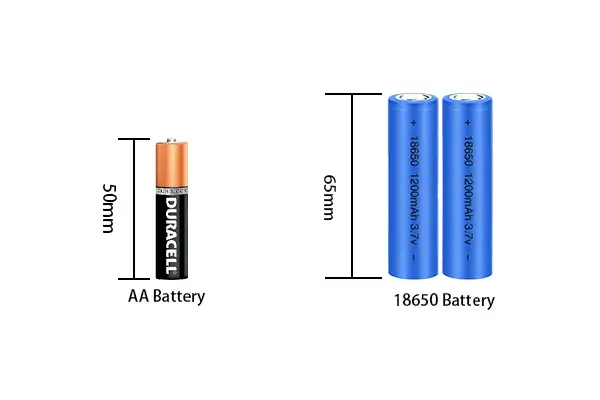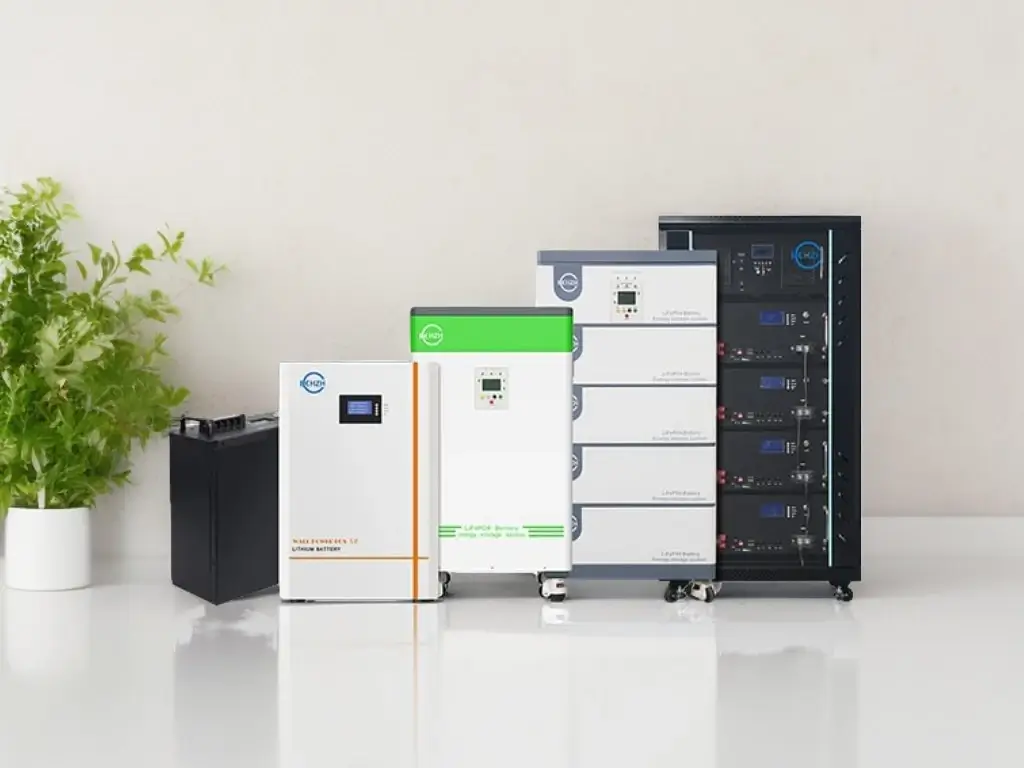Introduction
The quest for the ideal power source in our modern world of advanced devices and machinery has led to the development of various battery technologies. Each type of battery is tailored to specific applications and energy needs.

Understanding 18650 VS AA Battery: A Comparative Analysis
In this discussion, we delve into the advantages and disadvantages of two prevalent battery types: the 18650 VS AA battery. Both share a cylindrical form, which is their primary similarity, but they differ significantly in other aspects.
The 18650 Battery: A High-Capacity Option
18650 batteries, named for their dimensions of 18mm in width and 65mm in length, are a type of lithium battery. They stand out with a voltage range of 3.2V to 4.2V and boast a capacity ranging from 2500 to 3500 milliamp-hours (mAh). This makes them a powerful option for devices requiring more energy.
Learn more about Lifepo4 Lithium Battery Voltage Chart
AA Batteries: Versatile and Common
In contrast, AA batteries, typically found in alkaline form, measure 13.5-14.5mm (0.53-0.57in) in width and 49.2-50.5mm (1.94-1.99in) in length. They are produced using a variety of chemistries and typically have a nominal voltage of 1.5V. Their capacity ranges from 1500 to 2700 mAh, making them suitable for a wide range of everyday devices.
The Rechargeability of 18650 Batteries
18650 batteries are known for their rechargeable capabilities. These lithium batteries can be charged and used until depletion, then recharged for further use. Typically, 18650 battery packs, which include the widely used lithium iron phosphate (LiFePo4) type, are rated for 500 to 800 charge cycles. However, LiFePo4 batteries can reach up to about 4000 charge cycles. The charge and discharge rates vary, with energy storage batteries usually at 0.5-1C and power batteries at 3-5C. Notably, the LiFePo4 variant can sustain up to 4000 charge cycles before its performance falls below the manufacturer’s specified level. It’s important to note that in high-drain applications, the lifespan in terms of charge cycles may decrease significantly.
Rechargeable AA Batteries: Availability and Types
While most standard AA batteries are non-rechargeable alkaline types, there are several rechargeable variants available, thanks to the diverse chemistries used in their production. Unlike the uniformly rechargeable 18650 batteries, only certain types of AA batteries can be recharged.
All AA batteries share a common design – a single-cell cylindrical pack. To determine if an AA battery is rechargeable, one should check the label on the battery pack. Among the AA battery types, the rechargeable ones include Lithium-Ion, LiFePo4, Nickel-Cadmium (NiCd), Nickel-Metal Hydride (NiMh), and Nickel-Zinc (NiZn).
Comparing 18650 VS AA Battery: Key Differences
Size and Dimensions
A notable difference between 18650 and AA batteries lies in their size. The 18650 batteries are larger, Diameter 18mm, length 65mm. In contrast, AA batteries are smaller, with dimensions of 14.5mm by 50.5mm. This size distinction is easily observable and plays a significant role in their respective applications.
Voltage Specifications
When it comes to voltage, 18650 batteries offer a higher range, typically between 3.2V to 4.2V. AA batteries, on the other hand, have a lower voltage range, usually between 1.2V to 1.5V for single-cell types. This voltage difference is crucial for determining the suitability of each battery type for various devices.
Capacity Comparison
Capacity is another major area where 18650 and AA batteries differ. 18650 batteries generally have a higher capacity, ranging from 1500mAh to 3600mAh. AA batteries, while versatile, offer a lower capacity range, typically between 1500mAh to 2700mAh.
Performance and Energy Storage
In terms of performance, 18650 batteries can store more energy due to their higher capacity, allowing them to power devices for longer periods before needing a recharge. AA batteries, despite their lower capacity, are known for their high nominal voltage, making them ideal for high-drain and energy-intensive applications.
Applications and Usage
The usage of 18650 and AA batteries overlaps in some areas but also diverges. 18650 batteries are frequently used in portable electronic devices like laptops and flashlights, and are increasingly common in electric vehicles, including cars, bikes, and scooters. AA batteries are more suited for high-drain applications such as handheld power tools, and everyday home appliances like remote controls and thermometers.
Commercial Popularity: AA vs 18650 Batteries
In the realm of commercial popularity, AA batteries often outshine 18650 batteries. Commonly found in households and local stores, AA batteries are a staple in everyday devices due to their accessibility and compatibility with a wide range of products. Conversely, 18650 batteries, while less prevalent in typical consumer settings, have carved a significant niche in specialized devices, machinery, and electric vehicles globally. Their practical application in these areas often surpasses that of AA batteries.
Can AA Batteries Replace 18650 Batteries?
When it comes to substituting one for the other, using AA batteries in place of 18650 batteries is generally not advisable. The primary reason lies in the substantial differences in capacity and voltage requirements between the two. Devices designed for 18650 batteries typically demand higher voltage and capacity, which AA batteries cannot adequately provide. This mismatch in energy output can lead to inefficiencies or even damage to the device. Additionally, the physical size differences between these batteries can pose compatibility issues, further complicating any attempts at substitution.
Finding Alternatives to 18650 Batteries
While AA batteries are not an ideal substitute for 18650 batteries due to differences in capacity and voltage, there are other viable alternatives. A notable option is the 21700 rechargeable lithium-ion battery. These batteries are increasingly being recognized as a suitable replacement for 18650 batteries for several reasons.
The 21700 batteries share a similar voltage rating with the 18650s, ensuring compatibility with devices designed for the latter. However, the key advantage of 21700 batteries lies in their capacity. They offer a significantly higher capacity, with some models reaching up to 5000mAh. This increased capacity means longer usage times between charges, making them an excellent choice for high-demand applications.
In summary, for those seeking an alternative to 18650 batteries, 21700 rechargeable lithium-ion batteries present a compelling option, balancing similar voltage requirements with enhanced capacity for extended performance.




